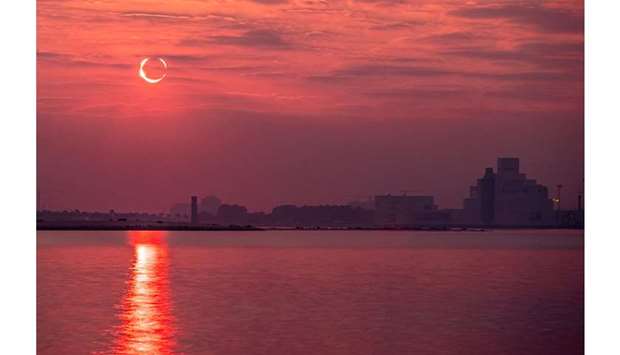It was a rare moment that can be seen once in over 100 years at the same place. The annular solar eclipse was visible in the eastern horizon of Qatar’s sky yesterday morning.
The residents of Qatar in general and the experts in particular took keen interest in the early morning natural phenomenon when the sun appeared as a “ring of fire’ after moon covered solar disk except for the outer periphery.
The last solar eclipse of this year was visible in Qatar where its peak moment was the time of the conjunction of new crescent of Hijric month “Jumada I 1441 H”. The very rare phenomenon last occurred over Qatar sky one and a half century back.
The solar eclipse was seen as annular eclipse from East-south of Saudi Arabia, South part of Qatar, parts of United Arab Emirates, Oman, India, and Indonesia, while it was seen as a partial eclipse from South-east of Africa, parts of Europe, Asia, and Middle east. The duration of all solar eclipse phases over its path was five hours and 35 minutes.
The solar eclipse started over Qatar sky as a partial eclipse at sunrise time at 6:17am, while the annular phase was seen by 6:35am. The partial solar eclipse phase over Qatar sky ended at 7:50am Doha local time.
Talking to Community, Dr Beshir Marzouk, astronomy expert at Qatar Calendar House, said: “Generally, the solar eclipses occur when the moon passes between the sun and the earth so that the sun is fully or partially covered. This can only happen before a new moon phase, when the sun and moon are in conjunction as seen from the earth. There are four types of solar eclipse: total, partial, annular and hybrid.
Highlighting the significance of the solar eclipse for the scientists and researchers, Dr Beshir said: “Solar and lunar eclipses are important phenomena because they validate astronomical calculations. The solar eclipses happen before the first of Hijric months (before new crescent), while lunar eclipse happens at the middle of Hijric months (at full moon phase). These natural phenomenon help the scientists correct their earlier data if there is some error. Such happenings further help the researchers study the orbits of different celestial objects. They can revisit their compiled data through these phenomena. The phenomenon can help in having better calculation of beginning and end of the Hijri months. The annular solar eclipse also helps the researchers to measure the diameter of the sun.”
Dr Beshir also called the eclipse a rare and nice opportunity for the public to witness the phenomenon. ‘It happens once at a same place after a century. For many people it is a life time opportunity to witness the celestial occurrence. It was visible with naked eyes but it is advised not to look at the ring of fire without sun glasses.”
Shahin Olakara is an expatriate from Kerala and works with a government department. He has the hobby of taking wildlife photos. He, however, took his chance to capture the eclipsed son early in the morning.
“I along with one of my friends decided to capture the rarest celestial moment. One day prior to the annular eclipse, we chalked out what time we need to be at the cornice to capture the rising sun. We wanted to get the eclipsed sun with some monument in Qatar. Finally we selected the place close to Oryx mascot overlooking the Museum of Islamic Art in the east.’
The photographer added: “I was not an easy shot to take. The sky was cloudy. I was not getting a complete view of the sun. Finally, at 6:35am, I saw a window of opportunity in the cloudy sky and capture the ring of fire with moon cover the central solar disk.
“I took keen interest in taking the photo only because it was a very rare moment in Qatar and in my life as well. I am happy that I have captured the phenomenon forever.”

SOLAR ECLIPSE: For many people in Qatar, the solar eclipse was a life time opportunity to witness the celestial occurrence. ttttttt Photo by Shahin Olakara


